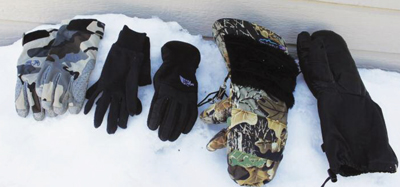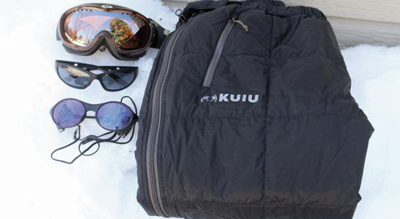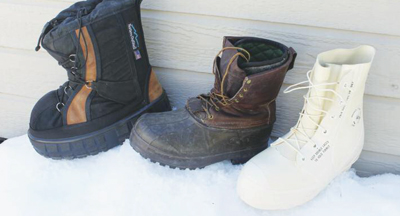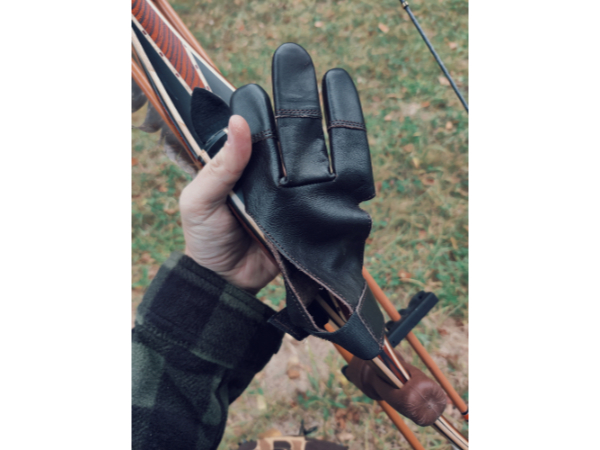The polar bear’s head bobbed in and out of sight as it moved through the slabs of broken ice. I leapt off of the dog sled, threw my mittens to the ground, and wrestled out of my heavy down jacket. Grabbing my bow and quiver, I ran forward in my clunky boots to face the most dangerous animal in North America…
I looked out the jet window as I flew north of the Arctic Circle. The western horizon was a pure white maze of broken ice and drifted snow. I couldn’t help but wonder if I was crazy to return to this frozen land. I’d spent three months testing clothing and gear, but I still doubted whether I could survive camping out on the frozen sea ice.
I’ve read articles about cold weather gear in hunting magazines for several decades. They all said the same things: dress in layers and buy some chemical hand and toe warmers. What I really needed to research was how a bowhunter, particularly a finger-shooting traditionalist, could shoot a bow when it’s below -10ºF. I was going to be living on the ice pack, not sitting in a tree stand 250 yards from a pickup truck. I needed gear that would allow me to survive without dependency on chemical hand and toe warmers. The one reason information is a little skimpy is that so few of us hunt here.
As a young boy, one of my jobs during the winter was to chop holes through the ice on cattle water troughs in Michigan. Years later I skied and snowboarded most of the major ski areas in the Rocky Mountains, climbed numerous 14,000 foot peaks, and hunted above the Arctic Circle several times. Even with my extensive experience with the cold, I needed to experiment with hats, boots, and coats that would provide warmth and mobility but still allow me to shoot my longbow accurately.
Jackets
My home near Denver got clobbered with two late season blizzards in April. Both times, I went to the archery range with a stack of clothing. Jackets included 1) Northern Outfitters Arctic Parka with a coyote trimmed hood; 2) Mountain Hardware goose down Mountaineering coat; 3) KUIU Super Down; and 4) Northern Outfitters Vaetrex 0° jacket.
The giant Northern Outfitters jacket was a must have for survival, but was impossible to shoot in due to poor bowstring clearance. The Mountain Hardware coat had some potential and I’d worn it on a prior arctic hunt, but the collar and hood were constantly interfering with my vision and bow string. With two regular arm guards or one extra-long arm guard, I could crank down the sleeve to accommodate my 6 ½” brace height, but I just could not shoot consistently.
Both the light weight Northern Outfitters and KUIU Super Down Jackets allowed enough arm clearance to shoot tight groups. When hunting on the ice, there is no way to know in advance how long a stalk or chase will last. With polar bear or muskox, there is always a strong possibility of an extended period of exposure to severe weather. Wearing one light jacket wasn’t sensible. Problem solved—I wore the Vaetrex jacket over my KUIU jacket and shot just fine. Luckily, the large Northern Outfitters Arctic Parka fit over the other two jackets, which would keep me warm while riding on the sled.
Gloves

Gloves for the arctic: KUIU Yukon Pro, Seirus Xtreme, The North Face Denali, Northern Outfitters, and Wiggy’s Trophy mittens.
Protecting a bowhunter’s hands in sub-zero temperatures is a necessity, but shooting a traditional bow while wearing bulky gloves is problematic.
While riding a snowmobile or a dog sled, Northern Outfitters Arctic mittens and Wiggy’s Trophy mittens with a liner glove served me well. Skin should never be exposed to the air, so it is important to wear liner gloves in mittens. I like Merino wool gloves. Whether a hunter is operating a camera, adjusting gear, or opening a backpack, it’s impossible to leave the large mittens on all of the time.
During the previously mentioned blizzards, I took a stack of gloves including 1) Army Surplus wool; 2) KUIU Yukon Pro; 3) Seirus Xtreme; 4) Merino wool from Cabela’s; and 5) The North Face Denali.
When holding a longbow with a bulky glove, the glove tends to ball up and lift the arrow off the arrow shelf. In addition to that fatal problem, a heavy glove or mitten inhibits a solid grip on the bow handle and allows a bow to torque upon release of the bowstring.
For the shooting hand, I wanted to find a glove that could keep my hand warm and still allow a clean release. After many test shots, the best glove for my bow hand proved to be the Seirus Xtreme with or without the Merino wool liner glove. The Army Surplus glove was fine for shooting, but it didn’t keep my hand warm enough in the wind and low temperatures. I generally use the Army Surplus wool gloves during deer season but I always have a hand-warming muff around my waist with a chemical hand warmer. That set up wasn’t practical in the Arctic.
I tried releasing arrows wearing all five gloves, and I just couldn’t get consistent releases. I ended up wearing a base Merino wool glove, and then put on an XL leather shooting glove, with a windproof Sitka glove with three fingers cut off on top. I think a bowhunter using a tab might do fine with the KUIU or Seirus gloves and a modified tab. It should be noted that in a pinch, at ranges under fifteen yards, I could release an arrow with all five gloves tested. However, I was hoping to be over fifteen yards away from a polar bear at the moment of truth.
Head Wear
A hood is mandatory in the Arctic, so it is important that any hat fits comfortably under a coat’s hood. The hat also must accommodate a facemask or balaclava, and goggles.
I’ve used many hats during cold weather hunts including 1) King of the Mountain Bomber; 2) custom made hats from beaver and coyote hides; 3) multiple stocky hats, including Wiggy’s, KUIU, and Icebreaker; and 4) Filson Tin Cloth Wildfowl.
I ended up using the Icebreaker Merino wool stocking cap under my beaver hide hat. Underneath the hats I wore a Smart Wool Merino wool balaclava. It’s very important when wearing goggles that there be no exposed skin between the goggles and balaclava. There is no downside to wearing two or three stocky caps in layers as long as the outer hat is windproof. However, the beaver hat was warmer and looked good.
Don’t attempt to shoot an animal with a hood over the hat without first practicing. I was not successful shooting with my hood up.
Eyes

Eye wear is vital. Also pictured are the KUIU Super Down pants.
There are multiple reasons for eye protection on an Arctic hunt. The most obvious is that constant sunlight on the bright, white snowpack requires tinted lenses to protect eyes from damage. If the temperatures aren’t too severe sunglasses are fine, as long as they have side shields to deflect the winds and snowflakes. I’ve used Julbo Sherpa sunglasses on several trips.
While riding a snowmobile or dog sled, goggles are preferable to shield one’s face and eyes from the severe wind chill. I prefer bronze or amber lenses. I met a hunter who cracked his goggles on the first day of the hunt and wore fogged and iced up goggles for the rest of the hunt. Therefore, I always take two pairs.
The Body
Protecting one’s body from the elements is not as specialized as the other clothing mentioned and has little to do with traditional bowhunting, unlike the items mentioned above. The Northern Outfitters Arctic Bib -60º, Cabela’s Trans Alaska Coveralls, and King of the Mountain Mule Skinner Bibs are good options, depending on expected temperatures. The most critical issue is that a hunter must not sweat. Wet clothing on skin is a disaster when it’s below zero. How will the clothes dry if it’s never above freezing? Wiggy’s makes a very good set of fishnet underwear (tops and bottoms) for that exact purpose. I’m also a huge fan of Merino wool. On my polar bear hunt, I wore Wiggy’s fishnet long underwear, two layers of KUIU merino wool (top and bottom), KUIU Super Down Pants, and the Northern Outfitters Arctic Bib -60º. Odds are when a hunter leaves town on a polar bear or muskox hunt, seven days later the hunter will still be wearing the same clothing. Merino wool stays notoriously fresh from body odor after extended wear.
Boots

Northern Outfitters, Schnee’s Extreme, and Bunny Boots.
There is a lot of debate and attention given to warm feet. I’ve used Schnee’s Extreme and Arctic Pro Muck Boots with good success. However, after talking with numerous Arctic hunting guides, there was a definite consensus that the military Bunny Boots are the best. The hard part is finding a pair of the real thing. I ended up finding a new pair at a Nome, Alaska sporting goods store. They are heavy but functional. I own the Northern Outfitters boots that many people have used in the Arctic but feel very clumsy in them on ice due to the hard plastic soles.
The Bunny Boots were my choice with good results. The downside is that my feet really sweat in them. A change of socks midday isn’t a bad idea.
Speaking of socks, don’t leave home without several pair of heavyweight Darn Tough or Smart Wool socks.
Everyone’s body is different, and there is a wide variety of cold tolerance. However, do not even consider going north of the Arctic Circle without extensive experimentation with all clothing, with specific attention to gloves and coats.
For six weeks prior to my polar bear hunt, I never shot my longbow without wearing my gloves. For the record, I stayed warm and my arrows flew true in the Arctic!
* * * * *
Gear Sources
* Nome Outfitters, Nome, Alaska: (907) 443-2880
* Wiggys: www.wiggys.com
* KUIU: www.kuiu.com
* Northern Outfitters: www.northernoutfitters.com
* Sunglasses: www.julbo.com
* Gloves: www.seirus.com







Leave A Comment